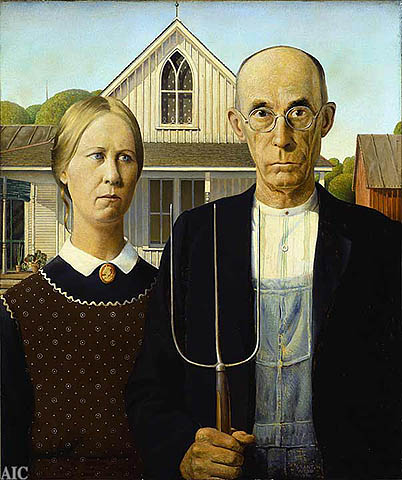"American Gothic" by Grant Wood

American Gothic is perhaps one of the most recognized paintings in American Art. This work was painted and created by the regionalist artist, Grant Wood from Iowa. This painting is often referred to as an American icon in our country. Grant Wood painted this work in the year of 1930, just as the depression was beginning to take over America and it was discovered at an exhibition at the Art Institute of Chicago. The painting won a bronze medal and a three hundred dollar prize (Stokstad 1101). This has often been a controversial painting in America because we are not sure if the man and the woman in the painting are supposed to be husband and wife, father and daughter, or perhaps sister and brother (Heritage 1). Many have found that in an interview with Wood in a 1933 article wood wrote that he “envisioned the pair as husband and wife. As a matter of Wood’s sister, Nan, posed as the woman in this particular painting (1). When the painting was unveiled in Iowa the natives of that state thought that Wood was mocking their culture. They thought that he was meaning to depict every Iowan as this rural type farmer and they became infuriated (2). Also, the clear age difference of the two subjects began to cause their own outburst among Wood’s Iowa hometown. So Wood decides to change his story on the pair and the two subjects became a small-town Iowa businessman and his daughter (3). We can also notice that the painting’s title is “American Gothic” and the reason being is that there is a distinct Gothic Window in the background of the painting so that was the reasoning for his title to this work. Wood got the inspiration for that window when he was traveling to Eldon, Iowa and when he saw the house he immediately sketched it on the back of an envelope (1). I believe that Wood was not trying to poke fun at the culture; he was simply just depicting the world that was going on around him. This is a very important painting when looking at American Studies in general what was meant to be real eventually became part of the popular culture as you can see in the slide show below. This painting has been redone several times with America’s popular figures many times involved in the renditions. We can never truly know what will stick out in America to become popular but I do not believe as simple as Grant Wood was that he would have anticipated that his work is an American historical icon that is here to stay.
 Plugin error: That plugin is not available.
Plugin error: That plugin is not available.
"American Gothic" and Pop Culture in America
“American Gothic” has become quite a popular icon for many Americans today. It is easily recognizable and it has been replicated into humorous cartoons among many other things. All these transitions are shown in the slideshow that is above this article. When watching the show notice that there are several renditions to this popular painting so many that perhaps we could call this Pop Art? Many disagree since pop art seems to have stemmed from the early modernists art movements in the 1930s. Take the article, “The Folklore of Industrial Society: Popular Culture and its Audiences” by Lawrence Levine for an example to this question. In the article Levine states, “Popular culture is seen as the antithesis of folk culture.” He also states that, “Popular culture should be used primarily to represent the consciousness of its producers, not its consumers.” (Levine 2). I have to agree with Levine on these factors of pop and folk culture. They are stems of one and another. I also believe that Grant Wood knew that what he was producing was going to become popular and also cause the controversy as it did. Remember bad press is still press. This work was getting recognized and many people knew that this painting depicted that rural life. As we all know not all Americans lived like this at the time but it was during the depression era that this type of rural life was prominent and very real to our culture. It becomes “popular” per say because it is what it is and there is no escaping it.
As we can conclude, Grant Wood knew that he had made a true work of art that would stick with our American Culture. Maybe not to the extent that the paintings popularity has reached in this modern day, I don’t think any artist would anticipate Bevis and Butthead in a rendition to a great work of art. This all goes to show the things that stand out among our culture and are truly a slice of American life. This painting is very important when reviewing American Studies. It tells a story of many of the common folk in America during the depression in our country and it also symbolizes the myth of the American through popular culture today.
Other Links
Works Cited
Levine, Lawrence W. "The Folklore of the Industrial Society: Popular Culture and its Audiences." The American Historical Review. Vol 97 (1992):1369-1370.
Present at the Creation: American Gothic. Narr. By Melissa Gray. National Public Radio. Morning Edition. 18 Nov. 2002.
Sister Wendy’s American Collection Online. 29 Aug. 2006. PBS. 20 Nov 2007. <http://www.pbs.org/wgbh/sisterwendy/works/ame.html>
Stokstad, Marilyn. Art History. Revised ed. New Jersey: Prentice Hall, 1999.
"Who's that Girl" American Heritage. April 2001. Online EBSCO: Academic Search FullTEXT Elite.
Wood, Grant. American Gothic. 1930. The Art Institute of Chicago.
Comments (1)
Anonymous said
at 3:03 pm on Dec 16, 2007
Ok, but Levine actually disagrees with the quotations you selected. Read the article carefully, and you'll see that he has a different conception of popular and folk culture.
You don't have permission to comment on this page.